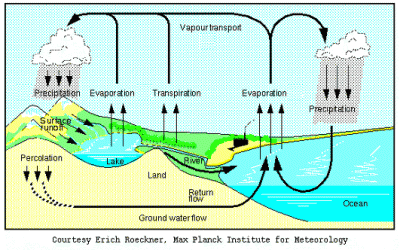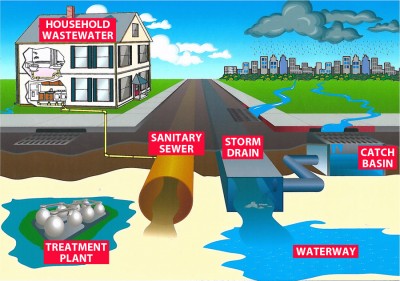Storm water is any type of precipitation that runs off a surface such as roofs, sidewalks, parking lots or roads into which it cannot seep. As cities expand and more roads, parking lots, and buildings are constructed, the way in which precipitation run-off can move through the landscape becomes more important and challenging. The water cannot remain on the surface without causing potential damage or diminishing the structural integrity of buildings and other manufactured surfaces. As a result, systems have been developed and engineered to manage storm water as it rains and snows.
WHAT IS A Storm Water CCTV Inspection
Storm water runoff management is an intricate system that many of us take for granted on a daily basis. It exists throughout our communities to maneuver rainfall and other collected water to collection basins and away from our residences and often mini ROVs like the Deep Trekker DTG3 are used to inspect these systems. There are many reasons why this water must be transported away, the main reason is to avoid flooding.
For a brief moment, let’s look at the basics of the water cycle:

As you may notice in this diagram, this is a completely natural environment. Regular surface runoff cannot occur once buildings, roads and other impermeable surfaces are constructed. This disrupts the water cycle and causes a variety of issues. The solution is to transfer the water in a similar pattern mechanically. Here is a diagram of a storm water system:

An important note to make from this is that the storm water and sewer lines are separate. The storm water falls as precipitation, flows over buildings and roads into the manholes where it then travels through pipe networks to storage basins and into natural or man made ponds or lakes. These man made lakes should not be mistaken for natural recreation areas; though wildlife may flourish around an open storm water basin, the water is often contaminated with oil from car drippings, pesticides from residential lawns and sediments of heavy metals especially around industrial areas (USEPA 2001). This water is not treated or used for drinking purposes generally because of these contaminants.
WHY MANAGE Storm Water CCTV Inspection
It is crucial to manage stormwater for several key reasons. From the health of local waters and aquatic life to flood risk mitigation, the correct management of stormwater is imperative.
Maintain the Hydrologic Cycle
Improperly managed stormwater can reduce moisture replenishment in the soil and minimize groundwater recharge. Soil moisture is essential for vegetation, while loss of groundwater recharge can severely reduce stream baseflow – water necessary for aquatic life. By managing stormwater correctly, the hydrologic cycle can be maintained to ensure healthy plant and aquatic life.
Prevent Flooding
Without adequate stormwater maintenance, the risk of flooding, especially in urban areas, is greatly increased. As water cannot be absorbed into the concrete that covers large swaths of towns and cities, the excess water from rain and thunderstorms must be managed to prevent loss of life and property damage by flooding.
Prevent Stream Erosion
While erosion is a normal part of stream behaviour, excess stormwater can greatly increase the amount of erosion as abnormal amounts of water enter streams during storms. This extra water increases both the volume and rate at which water – and the sediment in the water – is delivered to streams. This extra water can increase erosion on stream banks and beds, damaging the natural form of these streams. The degradation of these streams can lead to a massive decline in plant and animal diversity. Proper stormwater management can effectively mitigate these risks.
Storm Water CCTV Inspection Management
There are many precautionary measures besides the drainage network to prevent storm water from mixing with our drinking water resources, especially where our cities and roads are located directly adjacent to reservoirs. Here are some additional features throughout our cities that you may not realize are for storm water management:
Minimizing Directly Connected Impervious Areas
City planners will try to include a grassed area between a road and a water source. Grass lawns or other permeable, biological surfaces naturally filter some of the contaminants through the soil before the water finds its way into the aquifer.
Concrete Grid pavement
Voids in pavement allows the storm water to percolate through to permeable materials and then be filtered naturally.
Grassed Swales
Shallow, vegetated ditches directly beside roads that reduce the speed and volume of the runoff. Filtering can occur but the swales must shallow enough that they do not collect water to a point of being a small basin themselves.
Buffer Strips
Combinations of trees, shrubs and grasses planted along a stream. These strips should consistent of three zones: four to five rows of trees, then two rows of shrubs and finally 20 to 24 feet of wide grass. This reduces the velocity of the runoff and removes a good portion of solids before mixing with drinking water.
Filter Strips
Gently sloping vegetated areas surrounding a surface body of water. These hold the soil in place and act as a filter before storm water reaches the body of water.
Storm Water Ponds or Wetlands
Permanent ponds where solids settle between storms are created to collect the water. Storm water drainage efforts in surrounding areas are directed to the pond. These ponds often are used as visual features in communities or parks. The damage to the environment is minimal if managed properly and if the sediment is removed every seven to ten years.
Infiltration Practices
Narrow, stone-filled excavated trenches. These are deeper than grassed swales, the three to twelve feet deep trenches store runoff between the stones and slowly infiltrate the soil. When combined with other pre-treatment practices such as a swale, this method has been found to filter up to 98% of contaminants.
Swirl-type Concentrators
Underground vaults that are designed to create circular motion, creating sedimentation and oil and grease removal. The currents rapidly separate out settleable grit and floatable matter.
The cumulative effects of runoff being left unchecked can be dangerous. Inspection of each part of the storm water management system is key to maintaining the water cycle balance over the long term. Deep Trekker ROVs are used to inspect these networks. If do you have a system that’s overdue for an inspection, contact us to hear how we can help you.
DEEP TREKKER VEHICLES
Deep Trekker builds robust underwater inspection systems in the form of pipe crawlers and mini-remotely operated vehicles (ROVs). All Deep Trekker products are completely portable with on-board lithium batteries that provide 4-8 hours of run time, enough to do an entire inspection day’s work. The designed emphasis on portability and quick deployment means no additional components such as generators or dedicated service trucks are required. This also results in significant cost reductions and the ability to easily inspect in more remote areas.
DTG3 for Stormwater System
The DTG3 ROV system is the perfect tool to perform storm water basin inspections. Deep Trekker ROVs are built using a patented pitching system that allows the ROV to fly up, down, side to side, back and forth with only two thrusters. It is extremely easy to use and is operated with a game-style pad controller housing an integrated super bright viewing screen. Inspectors have everything at hand to monitor and inspect any system with ease.
DTG3 Use Case
The DTG3’s compact and spherical shape allows it to fit into as small as 14 inch pipes, with a 270 degree rotating camera allowing for thorough inspections even within those tight, confined spaces. The low light (0.01 lux) HD camera and high efficiency LED light mounted to the camera allow for inspections of “better than human eye” quality. This is important when entering murky waters with no direct sunlight.
Morris-Riley ROV pilots are able to lower the ROV by its tether into the pipes through access points, then view the live feed from their 5.6 inch LCD screen on the handheld controller. On extremely bright, sunny days, the pilot uses their Digital Video Recorder , allowing them to document every inch of their inspection. The DTG3 has up to an 8 hour battery life, allowing it to be deployed from even the most remote access points with no generators necessary.
DT340 for Stormwater Systems
The DT340 Pipe Crawler system is quickly becoming the “go-to” system for storm water pipe and drain inspections. With various wheel sizes and track options, Deep Trekker’s pipe crawler system is designed to effectively operate within a wide variety of pipe size inspections and soil types. The DT340S system sports a pan/tilt/zoom camera, steerable wheels and the same easy-to-use controller found on other Deep Trekker ROV systems.
Let us help find the right ROV for your underwater projects and applications CONTACT INDUSTRY SPECIALIST
WHY INSPECT STORMWATER SYSTEMS
Like any structural system, the integrity of infrastructure must be monitored and maintained. Regular inspections to ensure the condition of the pipes, drains, basins and other structures are imperative for safe storm water management. Issues like leaks, cracks, blocked pipes and sediment build up are common challenges that should be identified and addressed quickly. Submersible remotely operated vehicles (ROVs) are an effective, easy and cost-saving option for infrastructure inspection.
Deep Trekker’s underwater ROVs provide a safe and cost effective alternative to hiring divers, while pipe crawlers allow operators to explore pipes that are inaccessible to humans. The battery powered robots do not require topside power, making them easily portable and easy to deploy. Powerful cameras provide operators with a complete view of the area they are inspecting while also allowing for inspections to be recorded or photographed for further review. Add ons for the underwater ROVs and the pipe crawlers give operators advanced options such as laser scalers, Cygnus thickness gauges, and elevating arms.
Municipalities and contractors can be confident that they are providing the best possible storm water management system with regular inspections of key structures. Inflows, outflows, manholes, internal pipes and water basins must all be inspected regularly to ensure that they are operating at full capacity to prevent issues. Frequent inspections are key, as deficiencies can often multiply and compound as time goes by. By conducting consistent inspections, imperfections can be addressed before they become a costly issue.
Contact https://ven-techsubsea.ca today!!

